Pan Trapping and Malaise Trapping: A Comparison of Bee Collection Techniques in Subalpine Meadows
Abstract
:1. Introduction
2. Materials and Methods
2.1. Study Design
2.2. Identification
2.3. Data Analysis
3. Results
4. Discussion
5. Conclusions
Author Contributions
Funding
Data Availability Statement
Acknowledgments
Conflicts of Interest
References
- Goulson, D.; Nicholls, E.; Botías, C.; Rotheray, E.L. Bee declines driven by combined stress from parasites, pesticides, and lack of flowers. Science 2015, 347, 1255957. [Google Scholar] [CrossRef]
- Potts, S.G.; Biesmeijer, J.C.; Kremen, C.; Neumann, P.; Schweiger, O.; Kunin, W.E. Global pollinator declines: Trends, impacts and drivers. Trends Ecol. Evol. 2010, 25, 345–353. [Google Scholar] [CrossRef] [PubMed]
- Drossart, M.; Gérard, M. Beyond the Decline of Wild Bees: Optimizing Conservation Measures and Bringing Together the Actors. Insects 2020, 11, 649. [Google Scholar] [CrossRef]
- Aldercotte, A.H.; Simpson, D.T.; Winfree, R. Crop visitation by wild bees declines over an 8-year time series: A dramatic trend, or just dramatic between-year variation? Insect Conserv. Divers. 2022, 15, 522–533. [Google Scholar] [CrossRef]
- Ulyshen, M.; Horn, S. Declines of bees and butterflies over 15 years in a forested landscape. Curr. Biol. 2023, 33, 1346–1350. [Google Scholar] [CrossRef]
- Graves, T.A.; Janousek, W.M.; Gaulke, S.M.; Nicholas, A.C.; Keinath, D.A.; Bell, C.M.; Cannings, S.; Hatfield, R.G.; Heron, J.M.; Koch, J.B.; et al. Western bumble bee: Declines in the continental United States and range-wide information gaps. Ecosphere 2020, 11, e03141. [Google Scholar] [CrossRef]
- LeBuhn, G.; Vargas Luna, J. Pollinator decline: What do we know about the drivers of solitary bee declines? Curr. Opin. Insect Sci. 2021, 46, 106–111. [Google Scholar] [CrossRef] [PubMed]
- Formentin, G.E. Global bee population decline: A summary of the literature. Air Qual. Clim. Chang. 2022, 56, 42–45. [Google Scholar]
- Hamblin, A.L.; Youngsteadt, E.; Frank, S.D. Wild bee abundance declines with urban warming, regardless of floral density. Urban Ecosyst. 2018, 21, 419–428. [Google Scholar] [CrossRef]
- Pereira, F.W.; Carneiro, L.; Gonçalves, R.B. More losses than gains in ground-nesting bees over 60 years of urbanization. Urban Ecosyst. 2020, 24, 233–242. [Google Scholar] [CrossRef]
- Cane, J.H.; Tepedino, V.J. Causes and extent of declines among native North American invertebrate pollinators: Detection, evidence, and consequences. Conserv. Ecol. 2001, 5, 1–9. [Google Scholar]
- Pollinator Health Task Force. Pollinator Partnership Action Plan. The White House. 2016. Available online: https://obamawhitehouse.archives.gov/sites/whitehouse.gov/files/images/Blog/PPAP_2016.pdf (accessed on 28 June 2019).
- Gibbs, J.; Joshi, N.K.; Wilson, J.K.; Rothwell, N.L.; Powers, K.; Haas, M.; Gut, L.; Biddinger, D.J.; Isaacs, R. Does Passive Sampling Accurately Reflect the Bee (Apoidea: Bee) Communities Pollinating Apple and Sour Cherry Orchards? Environ. Entomol. 2017, 46, 579–588. [Google Scholar] [CrossRef] [PubMed]
- Schlueter, M.A.; Stewart, N.G. Native Bee (Hymenoptera: Apoidea) Abundance and Diversity in North Georgia Apple Orchards Throughout the 2010 Growing Season (March to October). Southeast. Nat. 2015, 14, 721–739. [Google Scholar] [CrossRef]
- Rhoades, P.; Griswold, T.; Waits, L.; Bosque-Pérez, N.A.; Kennedy, C.M.; Eigenbrode, S.D. Sampling technique affects detection of habitat factors influencing wild bee communities. J. Insect Conserv. 2017, 21, 703–714. [Google Scholar] [CrossRef]
- Wheelock, M.J.; O’Neal, M.E. Insect pollinators in Iowa cornfields: Community identification and trapping method analysis. PLoS ONE 2016, 11, e0143479. [Google Scholar] [CrossRef]
- Droege, S.; Tepedino, V.J.; Lebuhn, G.; Link, W.; Minckley, R.L.; Chen, Q.; Conrad, C. Spatial patterns of bee captures in North American bowl trapping surveys. Insect Conserv. Divers. 2010, 3, 15–23. [Google Scholar] [CrossRef]
- Campbell, J.W.; Hanula, J.L. Efficiency of Malaise traps and colored pan traps for collecting flower visiting insects from three forested ecosystems. J. Insect Conserv. 2007, 11, 399–408. [Google Scholar] [CrossRef]
- McCravy, K.W.; Ruholl, J.D. Bee (Hymenoptera: Apoidea) Diversity and Sampling Methodology in a Midwestern USA Deciduous Forest. Insects 2017, 8, 81. [Google Scholar] [CrossRef]
- Templ, B.; Mózes, E.; Templ, M.; Földesi, R.; Szirák, Á.; Báldi, A.; Kovács-Hostyánszki, A. Habitat-dependency of transect walk and pan trap methods for bee sampling in farmlands. J. Apic. Sci. 2019, 63, 93–115. [Google Scholar] [CrossRef]
- Carril, O.M.; Griswold, T.; Haefner, J.; Wilson, J.S. Wild bees of Grand Staircase-Escalante National Monument: Richness, abundance, and spatio-temporal beta-diversity. PeerJ 2018, 6, e5867. [Google Scholar] [CrossRef]
- Krahner, A.; Schmidt, J.; Maixner, M.; Porten, M.; Schmitt, T. Evaluation of four different methods for assessing bee diversity as ecological indicators of agro-ecosystems. Ecol. Indic. 2021, 12, 1075735. [Google Scholar] [CrossRef]
- Lindström, S.; Herbertsson, L.; Rundlöf, M.; Bommarco, R.; Smith, H.G. Experimental evidence that honeybees depress wild insect densities in a flowering crop. Proc. R. Soc. B: Biol. Sci. 2016, 283. [Google Scholar] [CrossRef]
- Townes, H. A light-weight Malaise trap. Entomol. News 1972, 83, 239–247. [Google Scholar]
- Koch, J.; Strange, J.; Williams, P. Bumble Bees of the Western United States; Stritch, L., Adams, L.D., Eds.; Pollinator Partnership: San Francisco, CA, USA, 2012; pp. 1–143. [Google Scholar]
- JMP, Version 17.2.0; SAS Institute Inc.: Cary, NC, USA, 2023.
- R Core Team. R: A Language and Environment for Statistical Computing; R Foundation for Statistical Computing: Vienna, Austria, 2021. [Google Scholar]
- Clarke, K.R.; Gorley, R.N. PRIMER v7: User Manual/Tutorial; PRIMER-E: Plymouth, MA, USA, 2006. [Google Scholar]
- Curtis, J.T. The Vegetation of Wisconsin: An Ordination of Plant Communities; University of Wisconsin Press: Madison, WI, USA, 1959; p. 657. [Google Scholar]
- Geroff, R.K.; Gibbs, J.; McCravy, K.W. Assessing bee (Hymenoptera: Apoidea) diversity of an Illinois restored tallgrass prairie: Methodology and conservation considerations. J. Insect Conserv. 2014, 18, 951–964. [Google Scholar] [CrossRef]
- Bartholomew, C.S.; Prowell, D. Pan Compared to Malaise Trapping for Bees (Hymenoptera: Apoidea) in a Longleaf Pine Savanna. J. Kans. Entomol. Soc. 2005, 78, 390–392. [Google Scholar] [CrossRef]
- Acharya, R.S.; Leslie, T.; Fitting, E.; Burke, J.; Loftin, K.; Joshi, N.K. Color of pan trap influences sampling of bees in livestock pasture ecosystem. Biology 2021, 10, 445. [Google Scholar] [CrossRef]
- Munyuli, M.B.T. Is pan-trapping the most reliable sampling method for measuring and monitoring bee biodiversity in agroforestry systems in sub-Saharan Africa? Int. J. Trop. Insect Sci. 2013, 33, 14–37. [Google Scholar]
- Cane, J.H.; Minckley, R.L.; Kervin, L.J. Sampling Bees (Hymenoptera: Apiformes) for Pollinator Community Studies: Pitfalls of Pan-Trapping. J. Kans. Entomol. Soc. 2000, 73, 225–231. [Google Scholar]
- Zameeroddin; Belavadi, V.V. Efficiency of hand net and Pan trap for collecting pollinators. J. Exp. Zool. India 2020, 23, 1259–1264. [Google Scholar]
- Joshi, N.K.; Leslie, T.; Rajotte, E.G.; Kammerer, M.A.; Otieno, M.; Biddinger, D.J. Comparative trapping efficiency to characterize bee abundance, diversity, and community composition in apple orchards. Ann. Entomol. Soc. Am. 2015, 108, 785–799. [Google Scholar] [CrossRef]
- Westerberg, L.; Berglund, H.; Jonason, D.; Milberg, P. Color pan traps often catch less when there are more flowers around. Ecol. Evol. 2021, 11, 3830–3840. [Google Scholar] [CrossRef]
- Chittka, L.; Raine, N.E. Recognition of flowers by pollinators. Curr. Opin. Plant Biol. 2006, 9, 428–435. [Google Scholar] [CrossRef]
- Hatfield, R.; Jepsen, S.; Vaughn, M.; Black, S.; Lee-Mäder, E. An Overview of the Potential Impacts of Honey Bees to Native Bees, Plant Communities, and Ecosystems in Wild Landscapes: Recommendations for Land Managers; The Xerces Society for Invertebrate Conservation: Portland, OR, USA, 2018; pp. 1–12. [Google Scholar]

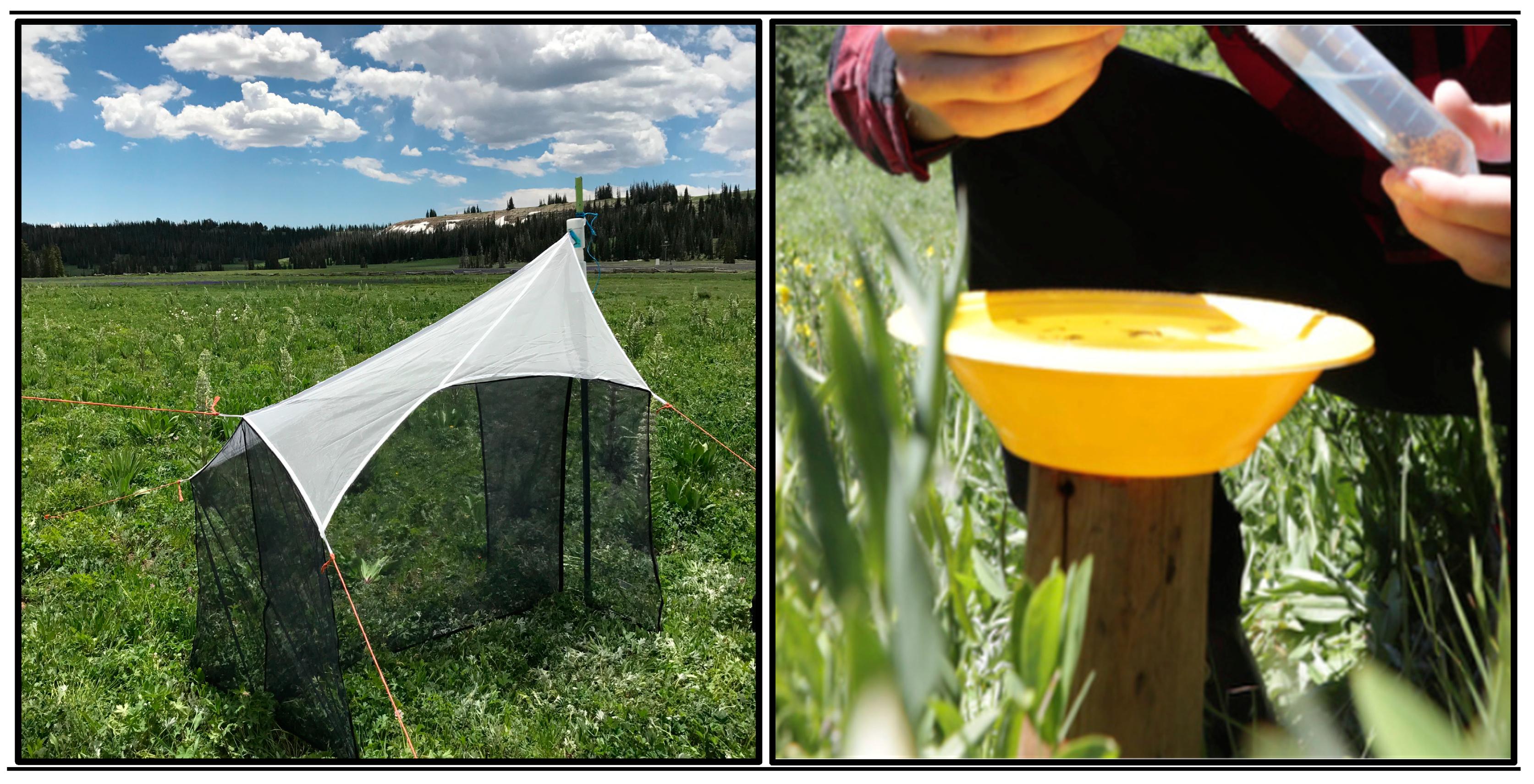
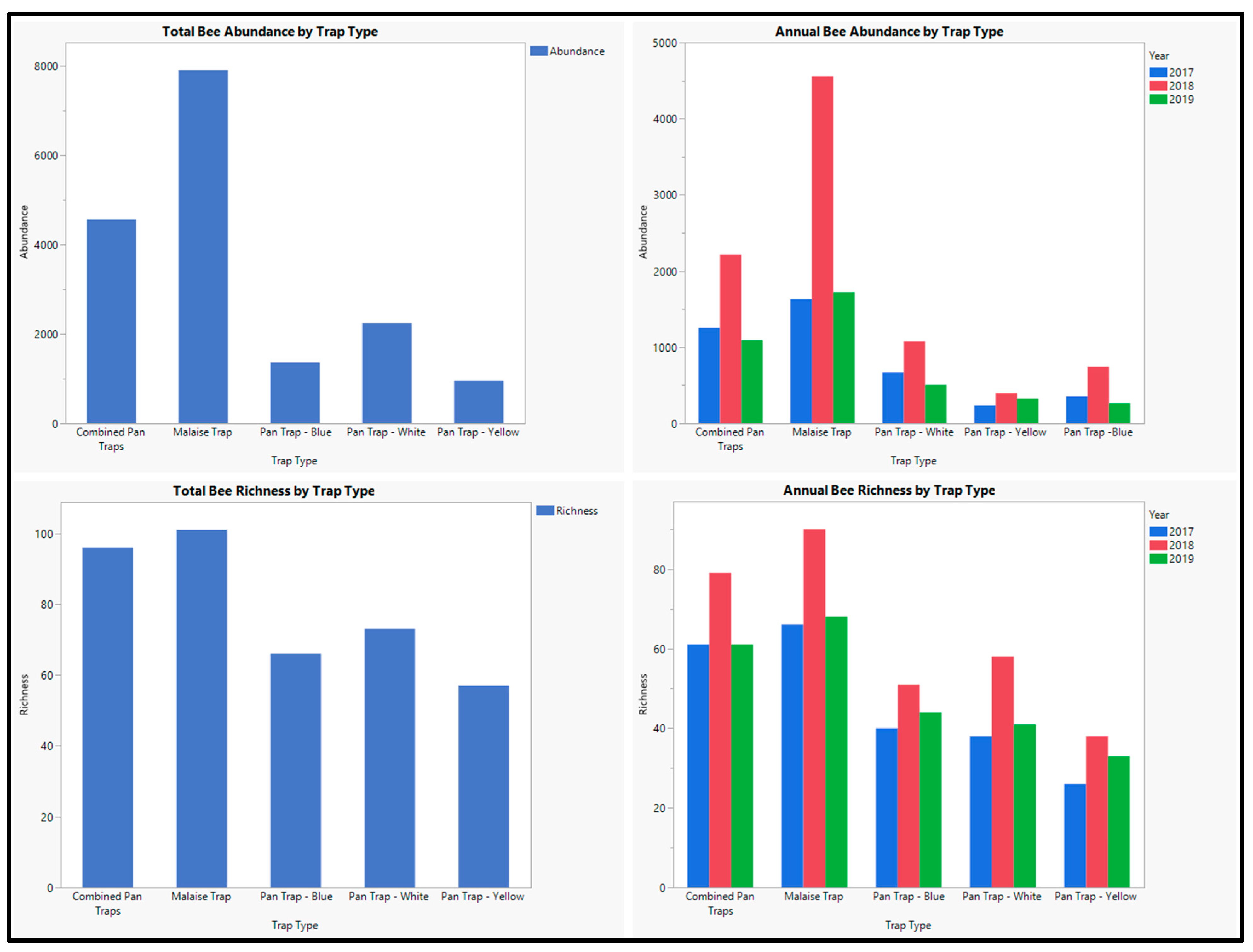
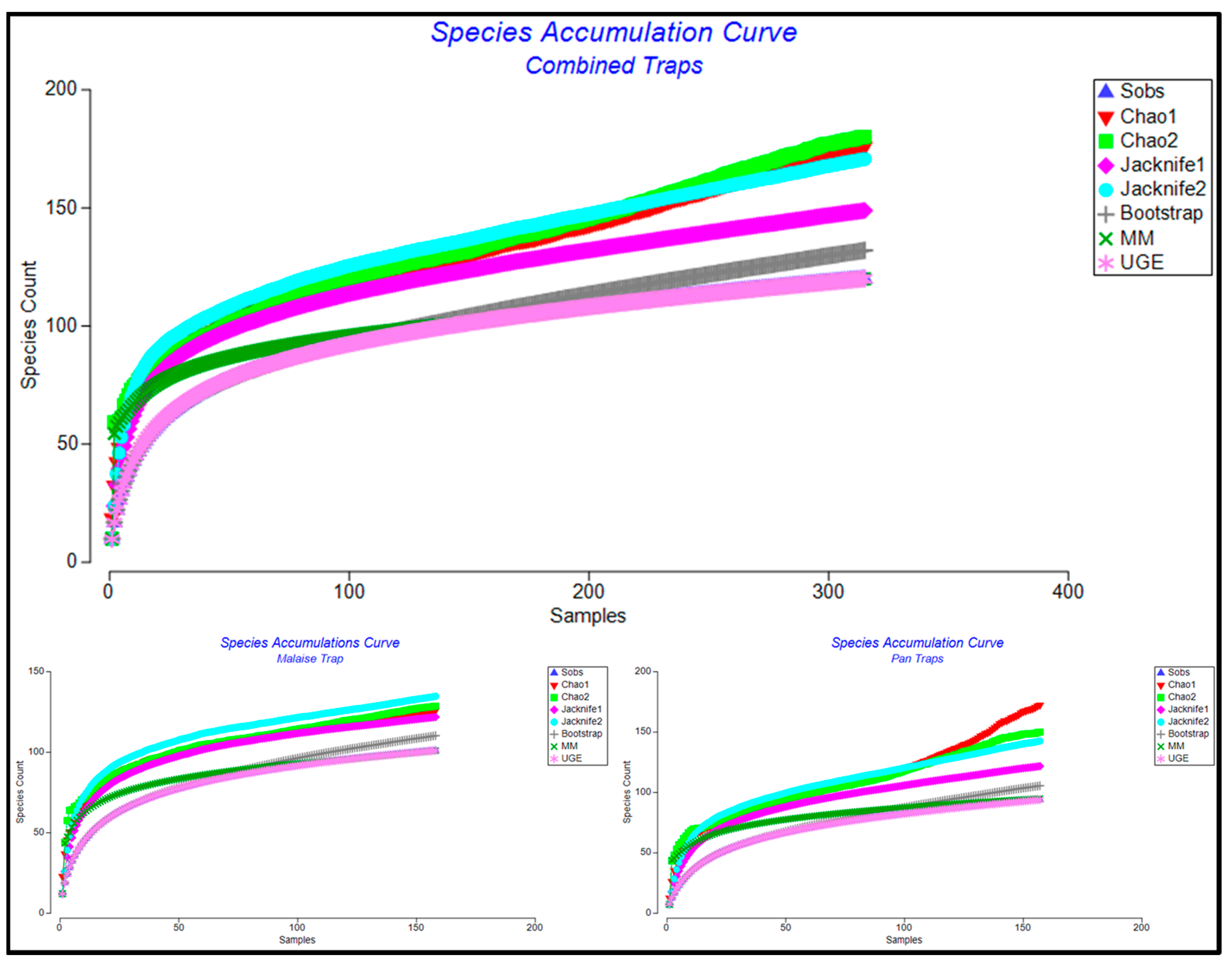
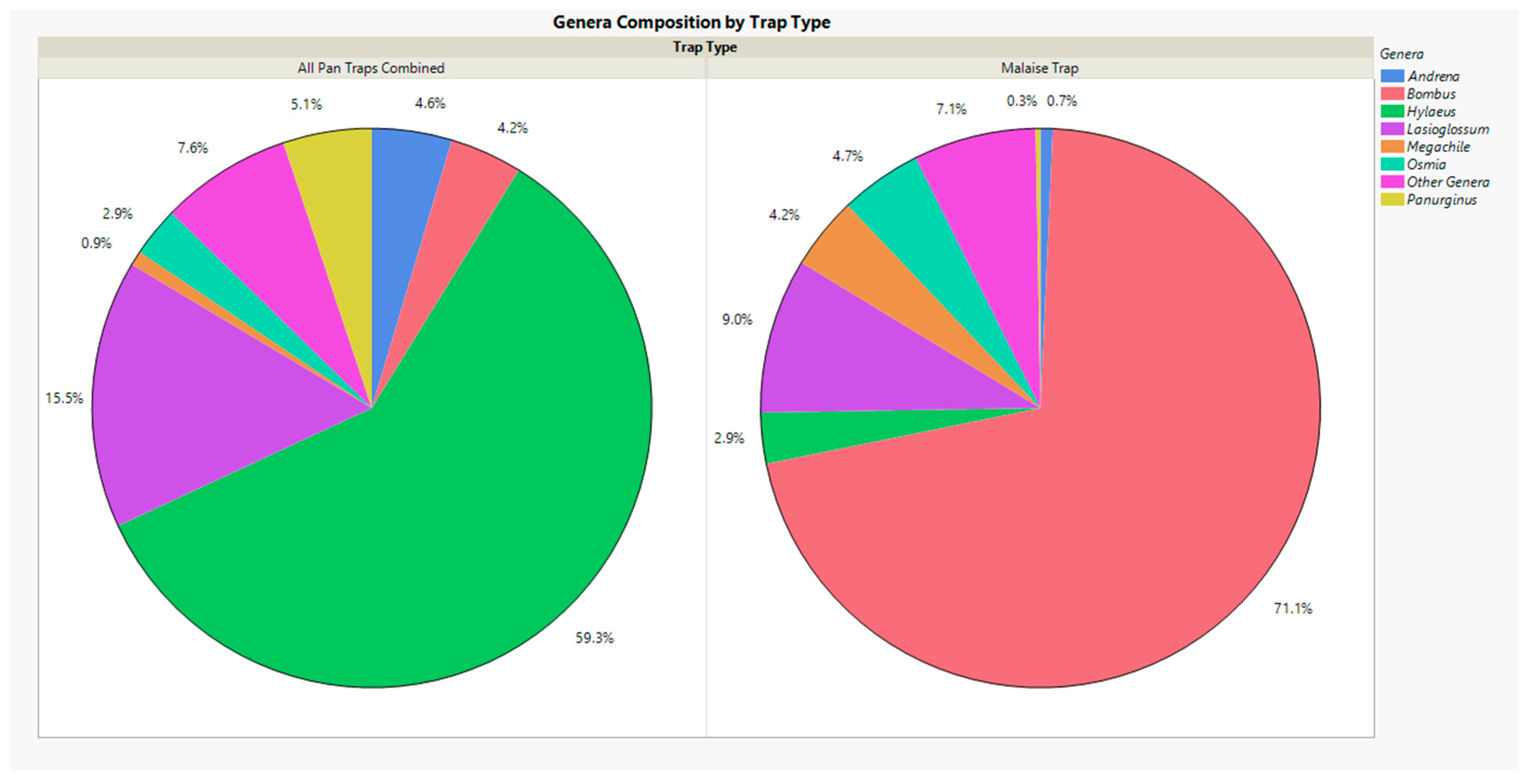
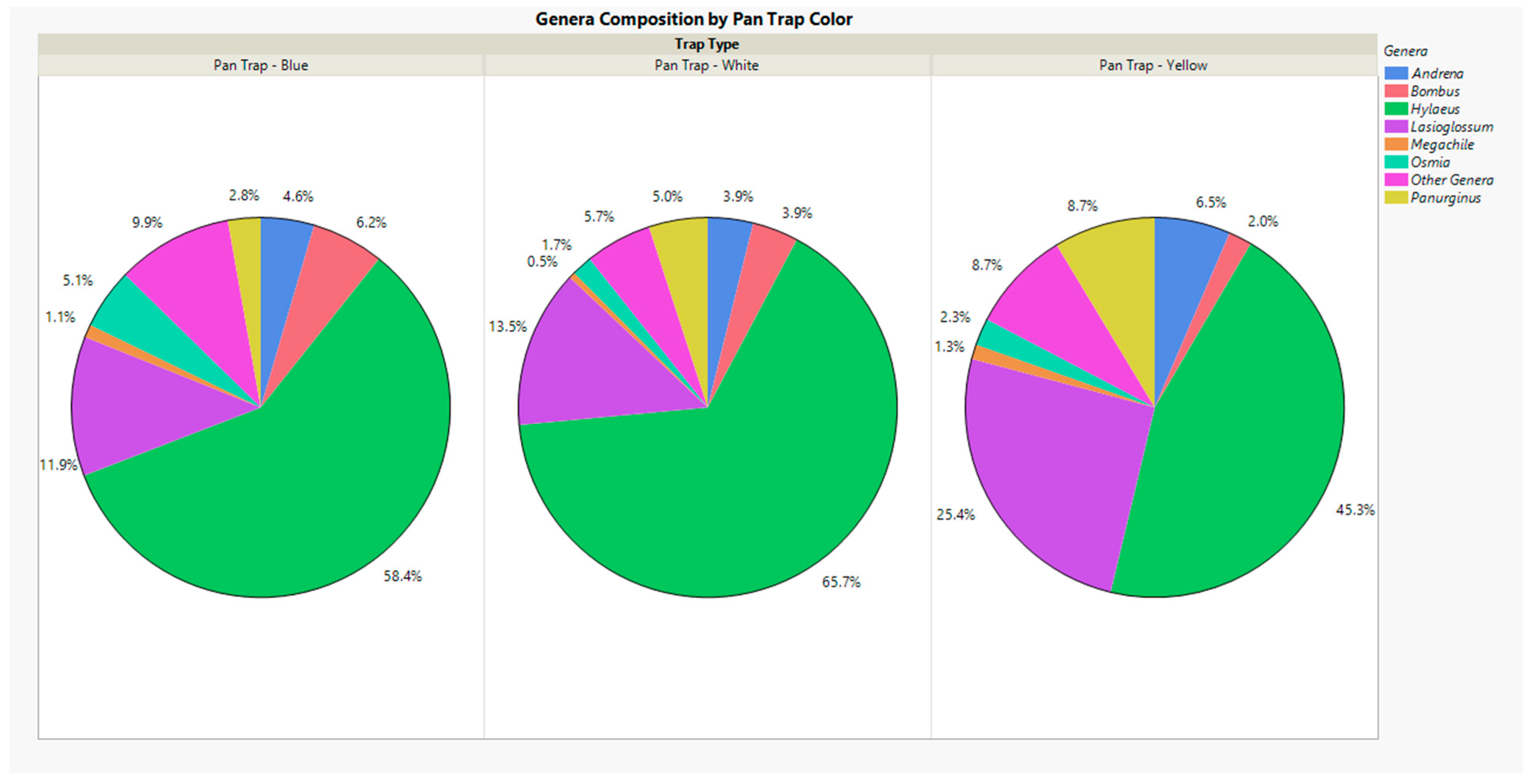
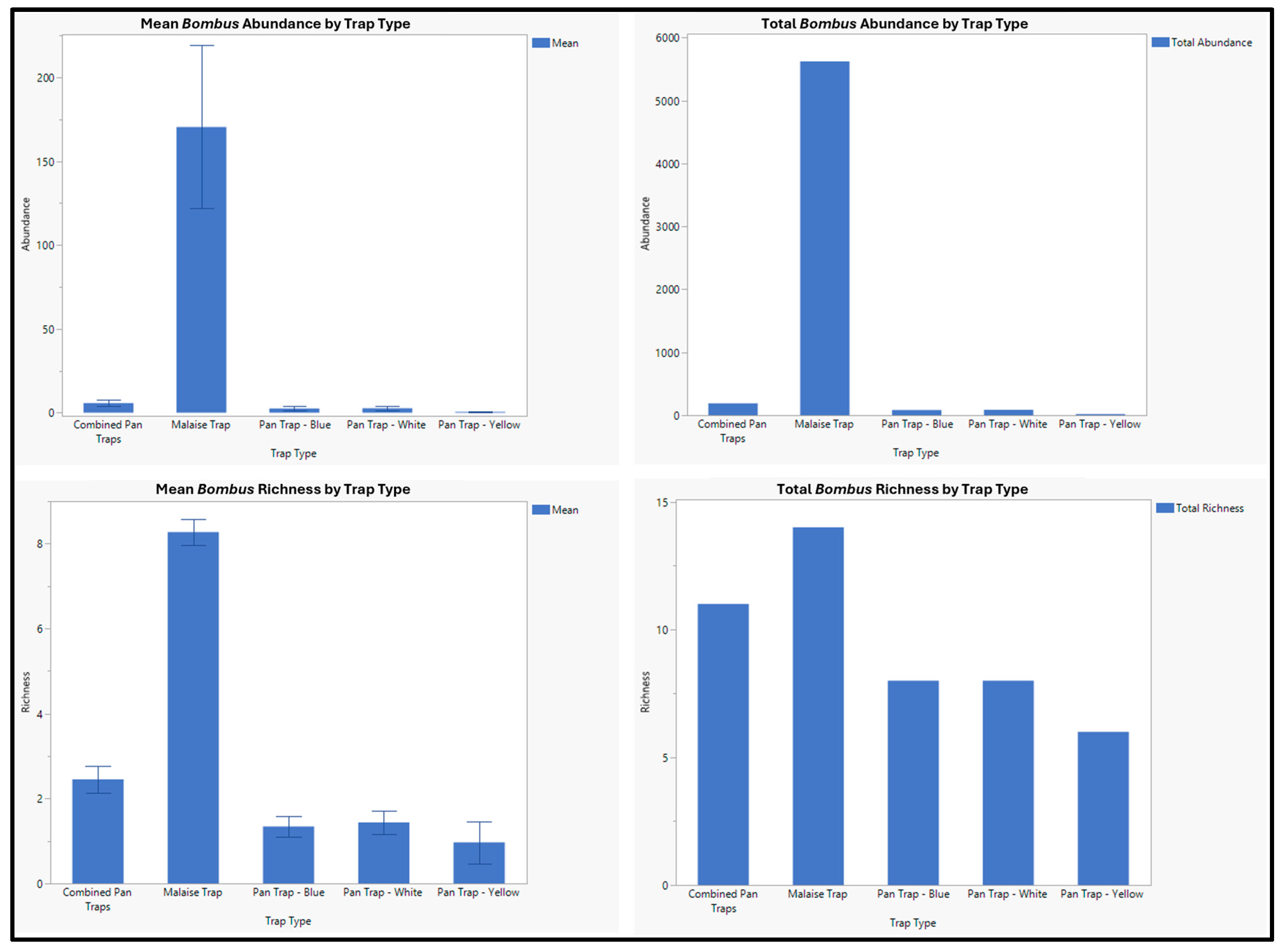


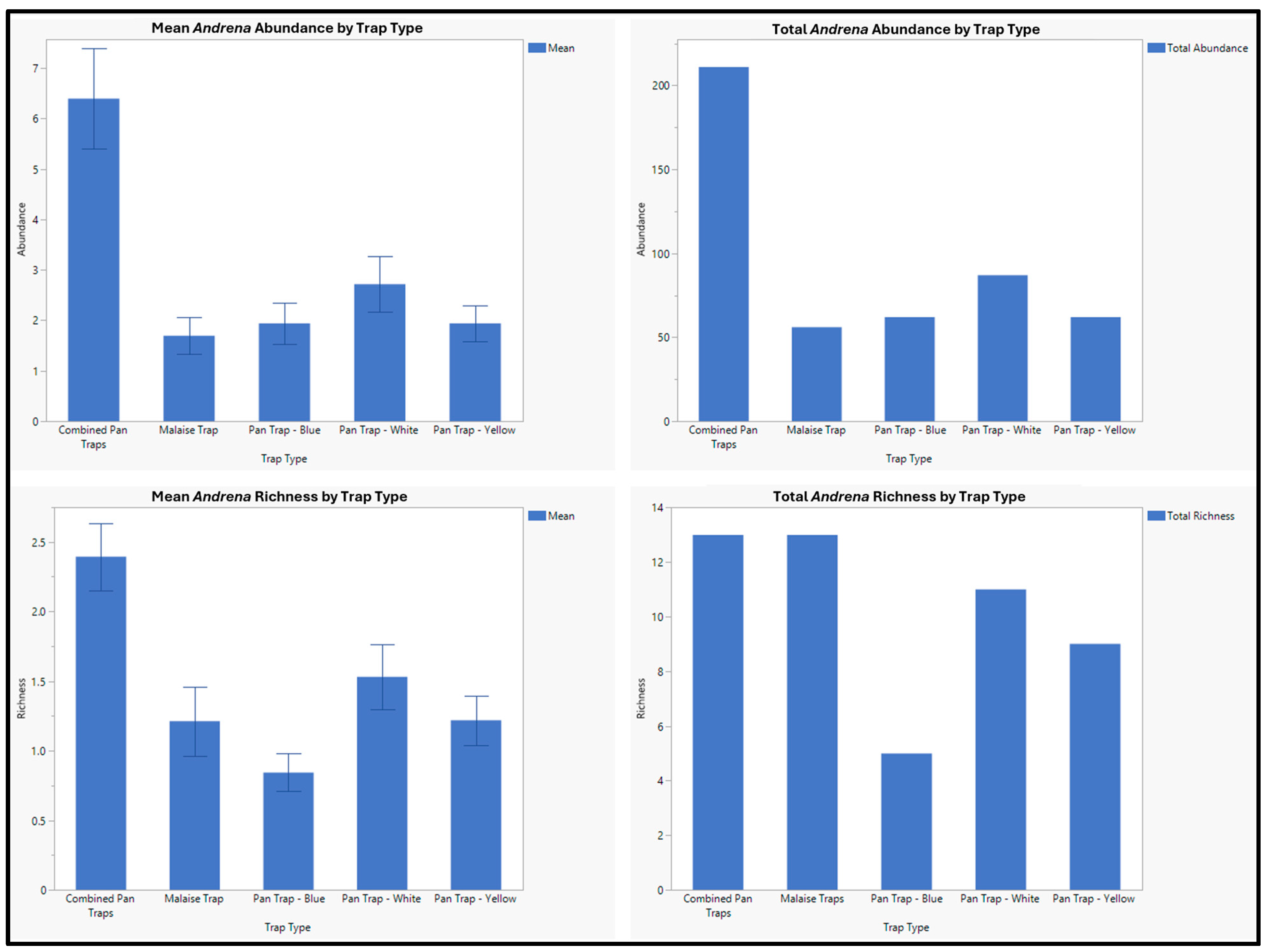
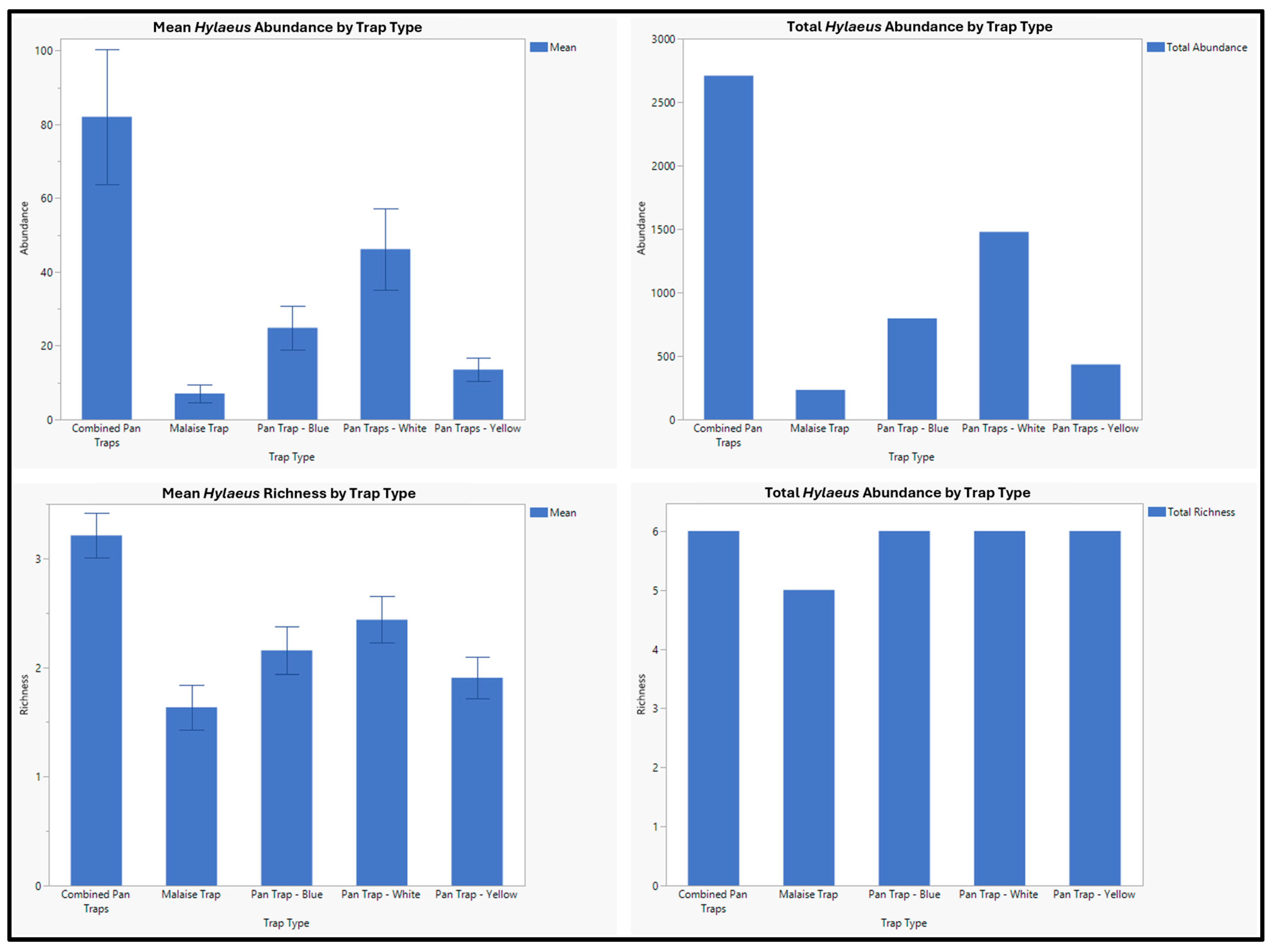


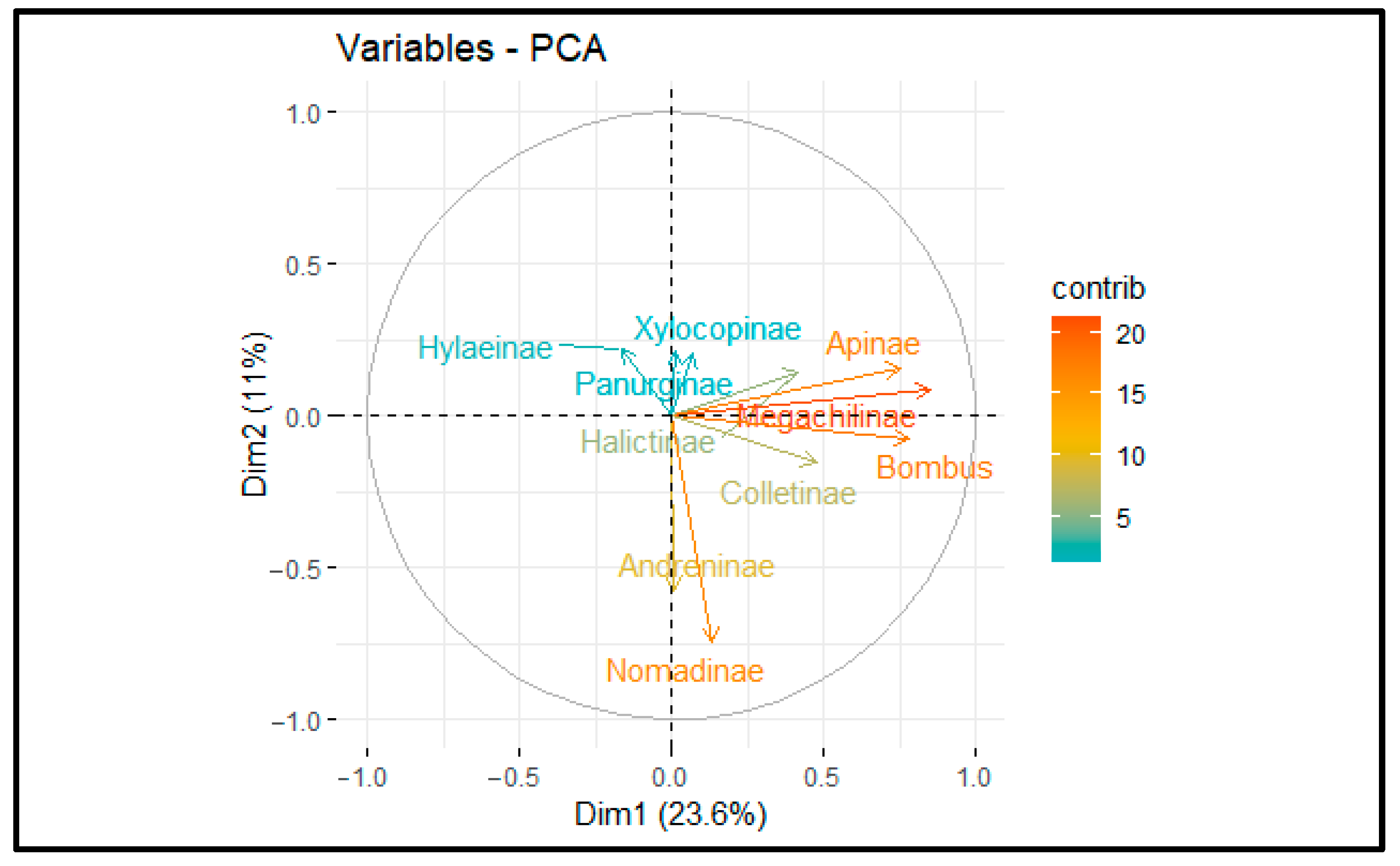
| Scientific Name | Common Name |
|---|---|
| Achillea millefolium Linnaeus, 1754 | common yarrow |
| Artemisia ludoviciana Nuttall, 1818 | cudweed sagewort |
| Aster ascendens Lindley, 1834 | Rocky Mountain aster |
| Collomia linearis Nuttall, 1818 | slenderleaf collomia |
| Delphinium nuttallianum Pritzel, 1843 | Nutall’s larkspur |
| Erigeron speciosus (Lindley, 1836) | aspen fleabane |
| Fragaria virginiana Duchesne, 1766 | wild strawberry |
| Geranium viscosissimum Fisher and Myer 1846 | sticky purple geranium |
| Helianthella uniflora Nuttall, 1842 | oneflower helianthella |
| Lathyrus lanszwertii Kellogg, 1861 | Nevada sweet pea |
| Ligusticum porteri Coulter and Rose, 1888 | Indian parsley |
| Lupinus argenteus Pursh, 1814 | silver-stem lupine |
| Mertensia ciliata (James, 1838) | mountain bluebells |
| Orthocarpus tolmiei Hooker and Amot, 1839 | Tolmie’s owl’s-clover |
| Osmorhiza occidentalis (Nuttall, 1859) | western sweet cicely |
| Penstemon rydbergii A. Nelson, 1898 | Rydberg’s penstemon |
| Polemonium foliosissimum A. Gray, 1878 | leafy Jacob’s ladder |
| Potentilla gracilis Douglas, 1830 | slender cinquefoil |
| Rudbeckia occidentalis Nuttall, 1841 | western coneflower |
| Smilacina stellata Linnaeus, 1753 | starry false Solomon’s seal |
| Solidago multiradiata Aiton, 1789 | Rocky Mountain goldenrod |
| Stellaria jamesiana Torrey, 1828 | James’ starwort |
| Taraxacum officinale Weber, 1780 | common dandelion |
| Thalictrum fendleri Engelmann, 1849 | Fendler’s meadow-rue |
| Vicia americana Muhlenberg, 1801 | American vetch |
| Viguiera multiflora (Nuttall, 1848) | showy goldeneye |
| Viola purpurea Kellogg, 1855 | goosefoot violet |
| Bee Species | Total | Malaise Trap | Pan Trap |
|---|---|---|---|
| Agapostemon femoratus Crawford, 1901 | 2 | 1 | 1 |
| Agapostemon texanus Cresson, 1872 | 1 | 1 | 0 |
| Andrena apacheorum Cockerell, 1897 | 23 | 2 | 21 |
| Andrena birtwelli Cockerell, 1901 | 13 | 2 | 11 |
| Andrena cerasifolii Cockerell, 1896 | 1 | 1 | 0 |
| Andrena chlorura Cockerell, 1916 | 42 | 14 | 28 |
| Andrena colletina Cockerell, 1906 | 1 | 0 | 1 |
| Andrena hirticincta Provancher, 1888 | 26 | 10 | 16 |
| Andrena laminibucca Viereck and Cockerell 1914 | 2 | 1 | 1 |
| Andrena miranda Smith, 1879 | 4 | 0 | 4 |
| Andrena surda Cockerell, 1910 | 1 | 1 | 0 |
| Andrena thaspii Graenicher, 1903 | 1 | 1 | 0 |
| Andrena vicinoides Viereck, 1904 | 18 | 7 | 11 |
| Andrena sp. 1 | 3 | 3 | 0 |
| Andrena sp. 2 | 1 | 1 | 0 |
| Andrena sp. 3 | 124 | 12 | 112 |
| Andrena sp. 4 | 1 | 0 | 1 |
| Andrena sp. 5 | 1 | 1 | 0 |
| Andrena sp. 6 | 2 | 0 | 2 |
| Andrena sp. 7 | 1 | 0 | 1 |
| Andrena sp. 8 | 1 | 0 | 1 |
| Anthidium tenuiflorae Cockerell, 1907 | 3 | 3 | 0 |
| Anthophora bomboides Kirby, 1837 | 5 | 5 | 0 |
| Anthophora terminalis Cresson, 1869 | 255 | 165 | 90 |
| Anthophora urbana Cresson, 1878 | 25 | 24 | 1 |
| Apis mellifera Linneaus, 1758 | 36 | 21 | 15 |
| Ashmeadiella bucconis Say, 1837 | 1 | 0 | 1 |
| Ashmeadiella pronitens (Cockerell, 1906) | 5 | 4 | 1 |
| Atoposmia sp. 1 | 1 | 1 | 0 |
| Bombus appositus Cresson, 1878 | 745 | 716 | 29 |
| Bombus bifarius Cresson 1878 | 1637 | 1582 | 55 |
| Bombus californicus Smith 1854 | 69 | 67 | 2 |
| Bombus fernaladae Franklin, 1911 | 50 | 50 | 0 |
| Bombus flavifrons Greene, 1860 | 1898 | 1839 | 59 |
| Bombus huntii Greene, 1860 | 18 | 18 | 0 |
| Bombus insularis Nylander, 1848 | 77 | 74 | 3 |
| Bombus melanopygus Cresson, 1878 | 1 | 1 | 0 |
| Bombus mixtus Cresson, 1878 | 95 | 92 | 3 |
| Bombus morrisoni Cresson, 1874 | 1 | 1 | 0 |
| Bombus nevadensis Cresson, 1878 | 28 | 27 | 1 |
| Bombus occidentalis Greene, 1858 | 40 | 38 | 2 |
| Bombus rufocinctus Cresson, 1863 | 198 | 185 | 13 |
| Bombus sylvicola Kirby, 1837 | 959 | 935 | 24 |
| Ceratina sp. 1 | 1 | 0 | 1 |
| Coelioxys funeraria Smith, 1854 | 1 | 1 | 0 |
| Coelioxys porterae Cockerell, 1900 | 6 | 3 | 3 |
| Coelioxys sp. 1 | 1 | 0 | 1 |
| Colletes fulgidus Swenk, 1904 | 23 | 16 | 7 |
| Colletes hyalinus Provancher, 1888 | 11 | 10 | 1 |
| Colletes kincaidii Cockerell, 1898 | 4 | 4 | 0 |
| Colletes nigrifron Titus, 1900 | 4 | 3 | 1 |
| Colletes paniscus Viereck, 1903 | 90 | 44 | 46 |
| Colletes simulans Cresson, 1868 | 4 | 4 | 0 |
| Diadasia sp. 1 | 1 | 0 | 1 |
| Dufourea harveyi (Cockerell, 1906) | 31 | 4 | 27 |
| Epeolus americanus (Cresson, 1878) | 3 | 2 | 1 |
| Epeolus minimus (Robertson, 1902) | 3 | 3 | 0 |
| Halictus farinosus Smith, 1853 | 5 | 2 | 3 |
| Halictus rubicundus (Christ, 1791) | 23 | 19 | 4 |
| Halictus tripartitus Cockerell, 1895 | 1 | 0 | 1 |
| Halictus virgatellus Cockerell, 1901 | 45 | 17 | 28 |
| Heriades cressoni Michener, 1938 | 13 | 4 | 9 |
| Hoplitis albifrons (Kirby, 1837) | 15 | 14 | 1 |
| Hoplitis clypeata (Sladen, 1916) | 29 | 10 | 19 |
| Hoplitis fulgida (Cresson, 1864) | 53 | 35 | 18 |
| Hoplitis producta (Cresson, 1864) | 15 | 4 | 11 |
| Hylaeus annulatus (Linneaus, 1758) | 2605 | 172 | 2433 |
| Hylaeus basalis (Smith, 1853) | 190 | 42 | 148 |
| Hylaeus coloradensis (Cockerell, 1896) | 63 | 6 | 57 |
| Hylaeus sp. 1 | 40 | 8 | 32 |
| Hylaeus sp. 2 | 6 | 0 | 6 |
| Hylaeus sp. 3 | 30 | 5 | 25 |
| Lasioglossum (Dialictus) spp. | 732 | 554 | 178 |
| Lasioglossum (Evylaeus) spp. | 230 | 82 | 148 |
| Lasioglossum (s. str. sp.) | 1 | 0 | 1 |
| Lasioglossum sp. 1 | 406 | 72 | 334 |
| Lasioglossum sp. 2 | 1 | 0 | 1 |
| Lasioglossum trizonatum (Cresson, 1874) | 2 | 1 | 1 |
| Megachile fidelis Cresson, 1878 | 2 | 1 | 1 |
| Megachile frigida Smith, 1853 | 27 | 25 | 2 |
| Megachile inermis Provancher, 1888 | 23 | 14 | 9 |
| Megachile melanophaea Smith, 1853 | 63 | 59 | 4 |
| Megachile montivaga Cresson, 1878 | 5 | 1 | 4 |
| Megachile nevadensis Cresson, 1879 | 1 | 1 | 0 |
| Megachile perihirta Cockerell, 1898 | 171 | 164 | 7 |
| Megachile pugnata Say, 1837 | 36 | 29 | 7 |
| Megachile relativa Cresson, 1878 | 43 | 38 | 5 |
| Melissodes hymenoxidis Cockerell, 1906 | 9 | 8 | 1 |
| Melissodes sp. 1 | 21 | 17 | 4 |
| Nomada sp. 1 | 1 | 0 | 1 |
| Nomada sp. 2 | 1 | 1 | 0 |
| Osmia albolateralis Cockerell, 1906 | 10 | 8 | 2 |
| Osmia brevis Cresson, 1864 | 11 | 4 | 7 |
| Osmia bucephala Cresson, 1864 | 85 | 55 | 30 |
| Osmia coloradensis Cresson, 1878 | 2 | 2 | 0 |
| Osmia ednae Cockerell, 1897 | 11 | 7 | 4 |
| Osmia montana Cresson, 1864 | 5 | 2 | 3 |
| Osmia paradisica Sandhouse, 1924 | 107 | 85 | 22 |
| Osmia pentstemonis Cockerell, 1906 | 20 | 17 | 3 |
| Osmia proxima Cresson, 1864 | 64 | 53 | 11 |
| Osmia pusilla Cresson, 1864 | 29 | 24 | 5 |
| Osmia raritatis Michener, 1957 | 1 | 0 | 1 |
| Osmia sculleni Sandhouse, 1939 | 112 | 89 | 23 |
| Osmia simillima Smith, 1853 | 12 | 5 | 7 |
| Osmia subaustralis Cockerell, 1900 | 7 | 6 | 1 |
| Osmia trevoris Cockerell, 1897 | 6 | 2 | 4 |
| Osmia tristella Cockerell, 1911 | 23 | 15 | 8 |
| Panurginus cressoniellus Cockerell, 1898 | 252 | 21 | 231 |
| Panurginus sp. 1 | 1 | 1 | 0 |
| Panurginus sp. 2 | 1 | 0 | 1 |
| Protandrena bakeri Cockerell, 1896 | 23 | 1 | 22 |
| Protandrena sp. 1 | 9 | 8 | 1 |
| Protandrena sp. 2 | 2 | 2 | 0 |
| Sphecodes spp. | 94 | 88 | 6 |
| Stelis foederalis Smith, 1854 | 8 | 4 | 4 |
| Stelis montana Cresson 1864 | 3 | 0 | 3 |
| Stelis nitida Cresson, 1878 | 7 | 0 | 7 |
| Stelis pavonina Cockerell, 1908 | 4 | 3 | 1 |
| Stelis subcaerulea Cresson, 1878 | 5 | 4 | 1 |
Disclaimer/Publisher’s Note: The statements, opinions and data contained in all publications are solely those of the individual author(s) and contributor(s) and not of MDPI and/or the editor(s). MDPI and/or the editor(s) disclaim responsibility for any injury to people or property resulting from any ideas, methods, instructions or products referred to in the content. |
© 2024 by the authors. Licensee MDPI, Basel, Switzerland. This article is an open access article distributed under the terms and conditions of the Creative Commons Attribution (CC BY) license (https://creativecommons.org/licenses/by/4.0/).
Share and Cite
Anderson, N.; Petersen, S.; Johnson, R.; Terry, T.; Kunzelman, J.; Lariviere, D.; Anderson, V. Pan Trapping and Malaise Trapping: A Comparison of Bee Collection Techniques in Subalpine Meadows. Diversity 2024, 16, 536. https://doi.org/10.3390/d16090536
Anderson N, Petersen S, Johnson R, Terry T, Kunzelman J, Lariviere D, Anderson V. Pan Trapping and Malaise Trapping: A Comparison of Bee Collection Techniques in Subalpine Meadows. Diversity. 2024; 16(9):536. https://doi.org/10.3390/d16090536
Chicago/Turabian StyleAnderson, Nicholas, Steven Petersen, Robert Johnson, Tyson Terry, Jacqueline Kunzelman, David Lariviere, and Val Anderson. 2024. "Pan Trapping and Malaise Trapping: A Comparison of Bee Collection Techniques in Subalpine Meadows" Diversity 16, no. 9: 536. https://doi.org/10.3390/d16090536
APA StyleAnderson, N., Petersen, S., Johnson, R., Terry, T., Kunzelman, J., Lariviere, D., & Anderson, V. (2024). Pan Trapping and Malaise Trapping: A Comparison of Bee Collection Techniques in Subalpine Meadows. Diversity, 16(9), 536. https://doi.org/10.3390/d16090536






